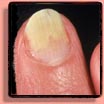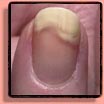Onycholysis Fingernail & Toenail Disorders |
Find your Nail Disorder problem!
The most common nail disorders and nail diseases are:
Beau's Line - Black Toe Nail - Brittle Nails - Nail Clubbing - How to cure Nail Fungus - Nail Disorder - Nail Fungus - Infection - Koilonychia - Leukonychia - Onycholysis - Paronychia - Nail Pitting - Red Nails - Nail Ridges - Split Toe Nail - Nail Pitting - Toe Nail Fungus - Diabetes & Nails - Psoriasis Nails - Rheumatoid Nails - Nail Fungus Treatment - Nail Biting Remedies - Nail Biting Treatment - Toddlers & Nail Biting - Japanese Nail Art - Acrylic Nail Art - Artificial Nail Art
[ Read more about Nail Disorders ]
|
|
Browse the Nail Encyclopedia!
Major items in the Hand Research Nail Encyclopedia are:
The Psychology behind Nail Biting
Nail Diseases
Nail Disorders
Nail Products
Nail Art Resources
Discover the world of the nails:
[ The Hand Research Nail Encyclopedia ]
|
|
NAIL ENCYCLOPEDIA - FINGERNAIL NEWS
|
|
|
separation of the nail plate!
How to recognize Onycholysis Nails?
Onycholysis is the painless separation of the nail from the nail bed. This is a common problem. It can be a sign of skin disease, an infection or the result of injury, but most cases are seen in women with long fingernails. The nail acts as a lever, prying the nail away from the skin and preventing healing of otherwise insignificant insults. Onycholysis is more specific: the loosening of the exposed portion of the nail from the nail bed, usually beginning at the free edge and continuing to the lunula. It is frequently associated with an internal disorder, trauma, infection, nail fungi, allergy to nail enhancement products, or side effects of drugs.
People of all ages, sex and race can get onycholysis, although it is more frequently seen in female adults. Because so many things can cause onycholysis, your doctor may examine you to check for other skin conditions or medical problems such as thyroid disease. If a fungal infection is suspected, your doctor may clip the nail and scrape a sample of tissue from beneath the nail plate for laboratory testing.
Onycholysis: Treatment & Prevention.
TREATMENT:
No matter what the cause, usually several nails are affected. Infection with bacteria and yeast starts to occur in the space under the nail. For treatment all of the unattached nail must be clipped off. The hand should be kept out of water as much as possible. Use gloves when cleaning and washing. It is very important to avoid mechanical cleaning under nails. One should not bandage or cover the cut nails. A drying agent such 3% Thymol in alcohol (by prescription) should be used after washing hands or getting hands wet for two or three months. Trim the nails back daily with a clipper until reattachment is seen. Additional medications by mouth may be needed in some cases.
PREVENTION:
Tips to prevent deterioration or recurrence of onycholysis after it has cleared up:
• Clip the affected portion of the nail, and keep the nails short.
• Avoid injuring the affected nail, and keep the nail bed dry.
• Avoid exposure to contact irritants such as nail enamel and enamel remover or solvents and detergents.
• Wear light cotton gloves under vinyl gloves for wet work.

More:
ONYCHOLYSIS
described in the Nail Tutor!
SECTION: NAIL DISORDERS
|
|
© COPYRIGHT 2002-2017: |

